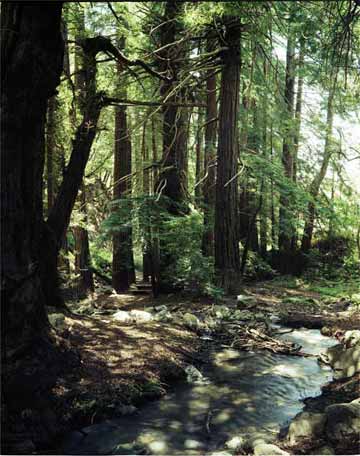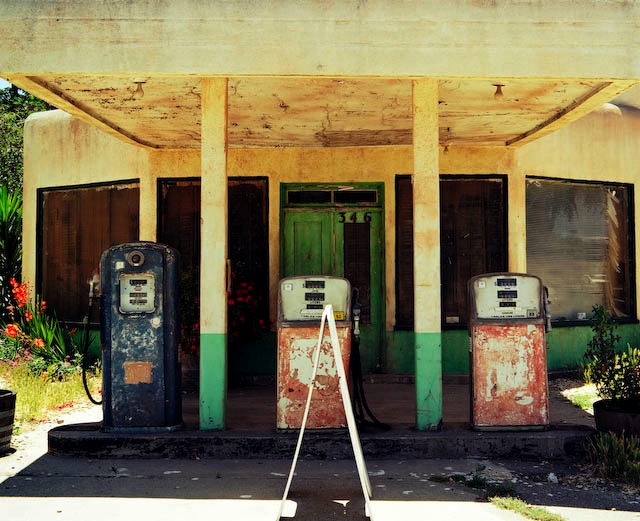I finally got the first 4â€x5†negatives back from the processor and began making some 13†x 19†prints. Amazingly, I had managed to load the film in the right way around and all the exposures, using my highly refined Modified Zone System (see June 25, 2005, below), were spot on. It probably did no harm to use negative film with its enhanced latitude for error even if the orange masked-negatives are harder to evaluate than transparencies.
My first reactions on getting the 13 negatives back was shock – those are really large pieces of film – and satisfaction when I saw just the very high level of definition they possessed. The mask in my flat bed film holder is actually 3.7†x 4.7â€, so a 13†x 19†print works out to an enlargement ratio of only 4x so it’s hardly a surprise to see that sharpness and detail are the order of the day.
On my first outing I had taken just four pictures, constrained by the fact that the Crown Graphic camera came with just two film holders. One of those four was double exposed. Don’t ask. What with all the rushing water and beauty of nature going on, I couldn’t hear the shutter trip so tripped it….again. Now if I had been using a Holga or similar toy camera the result would have immediately qualified as Art, but I instead consigned it to the round file.
On my second outing I had taken 12 more pictures, using the six additional film holders I had since acquired. Well, that turned out to be 11 pictures as I had inserted one of the film sheets incorrectly and had to pull the holder out of the camera without its dark slide, the latter proving impossible to replace. There I am, standing in the middle of the street, struggling with a sheet of film, more than a tad over-exposed, hoping no one was witnessing this debacle. Indeed, I found out that I have to do a good deal more practicing with film loading as a couple of my other shots were less than centered on the sheet. However, the film is so much thicker than 120 roll film that handling it is a joy and no cotton gloves are needed as it does not buckle when held by the edges.
Scanning on my flatbed was very simple, if slow, at 2400 dpi – I reckon that will give me the requisite 300 dpi at an 8x enlargement ratio, which is a print sized no less than 32†x 40â€. Now that is really large! I found there is no need for a glass film holder, once more thanks to the high rigidity and flatness of the negative. The scans in PSD or TIFF format come in at 280 megabytes, give or take, and that takes a while to load on the computer.
Over the past week I had finally bitten the bullet and decided to upgrade my outstanding Apple iMac G4 (the one that had locked up once in thirty months on, you guessed it, a Microsoft Excel spreadsheet) to an iMac G5. A colleague had reported how his dad was loading large files in no time, so it wasn’t just the mildly enhanced CPU speed at work – Apple must have done something to upgrade image processing. By way of comparison, as 250 megabyte medium format scan which would take 90 seconds to load now loads in 10 (yes, 10!) and all related actions – like rotation, levels, sharpening, etc in Photoshop are similarly faster. The time savings really add up, for 90 seconds is too short to leave the computer to do something else and too long to be fun.
Once I took a hard look at the scans I could see that the four element Schneider Xenar lens – probably single coated given it’s 40+ years in age – is a tad prone to flare into the light, so I will have to watch that, but covers with high resolution to the edges of the frame, although I should add that I have not used any swings or tilts to really test edge definition.
Anywhere, here is a much reduced version of my first every 4†x 5†photograph in one of the magnificent redwood forests off Highway 1 in California – 4 seconds at f/32 if you must know:

On my second outing I had decided to use the Crown as a hand held rangefinder camera and while this occasioned more than one questioning look from passers by (they did at least give me generous space on account of my presumed lunacy), it turned out to be wonderfully engineered for just this purpose, even if film changing is a bit of a challenge if you only have two hands. The New York street photographer of the 1940s, Weegee, knew what he was on to.
Here’s the first hand held shot in one of those many broken down old towns in central California:

So, all in all, this Crown Graphic experiment has all the makings of a beautiful friendship, once I learn to load those film holders correctly.
